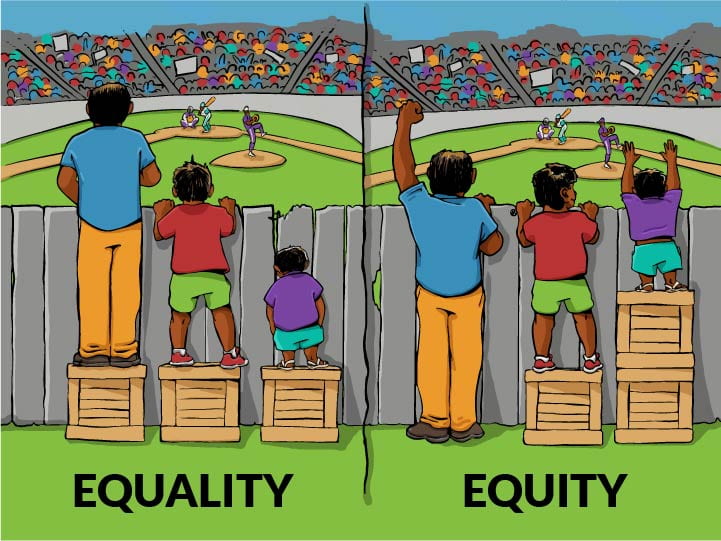Providing learning materials and activities in the online environment, so that all students can learn, is imperative for equity and inclusion within the course. Under the Americans with Disabilities Act (ADA) of 1990, all people with disabilities are afforded the “equal opportunity as those without disabilities, no matter the sector (transportation, school, work, etc.)” (United States Department of Justice [DOJ], n.d., para. 1). Only individual students with documented needs are guaranteed specific accommodations under the ADA, to help make learning more accessible. In a higher education setting, these accommodations can be anything from extended time on assessments to screen reading software on their devices. By adding accessibility to the learning materials and activities within the course, faculty can make learning available for those students who may need some assistance but do not have a documented need.
Unfortunately, adding accessibility to a course is not always considered, which in the end could negatively affect those who need it. There are several reasons this is occurring:
- Faculty do not think about it or simply forget to incorporate it
- Faculty lack proper training on how to properly incorporate it
- Faculty are not interested in taking the necessary steps to incorporate it
- Faculty have a misunderstanding on which materials need accessibility added
No matter the reason, a helpful solution is providing ample opportunities for faculty to be introduced, re-introduced, reminded, and properly trained by offering accessibility training (webinars, workshops, guides, etc.). By keeping this practice in the forefront of faculty’s minds it can also help to make the enactment occur more readily. This action would fall in line with the DEI (Diversity, Equity, and Inclusion) initiatives put forth by the university.
ADA and the Classroom
As stated previously, the ADA was added to the category of civil rights laws that attempt to “add equity to spaces without it for people with disabilities, to achieve equality” (DOJ, n.d., para. 1). Equity means that an individual’s needs are recognized and that resources are provided to ensure fairness and equality (Merriam-Webster, n.d.; Morton & Fasching-Varner, 2015). Equality means the same treatment is afforded to everyone as it pertains to “equal access to opportunities and benefits in society” (Anderson, 2022, p. 4).
This allows for services provided by the law to be used by those who need them but can also be used by all. By doing so, it establishes environments and situations that are inclusive for everyone. For example, ramps for elevated surfaces. These were intended for those in wheelchairs. Ramps could also be helpful for users of assistive equipment (walkers, canes, or clutches), strollers (or other wheeled contraptions), pain sufferers, and those with recent injuries or surgeries.

(Interaction Institute for Social Change & Maguire, 2016)
Implementing Accessibility
The D2L Brightspace LMS (Learning Management System) is already accessible, but when it comes to adding accessibility to learning materials and activities, each object has its own set of features to be added. Below are simplistic tables, with the key features, for reference. Notice that objects are separated by “text only” and “others” in the separate tables, to make for easier usage. Microsoft Office applications and Adobe Acrobat have accessibility checkers built into them to identify the issues and information on how to fix them. For further assistance, please reference this website on Tools for Promoting Disability Access and Inclusion.
Object (text only) |
Features |
How it helps |
PowerPoint slides |
|
|
WORD |
|
|
PDFs |
|
|
Excel Spreadsheets |
|
|
Tables |
|
|
Object (Other) |
Features |
How it helps |
Videos |
|
|
Images |
|
|
Audio (only) |
|
|
Links (to outside sources) |
|
|
Colors |
|
|
There are a couple of places that could offer assistance for faculty and staff who need it. The first is the Student Accessibility Services (SAS), which assists students, faculty, and staff with the accommodations they need to be successful. SCSU Online is also equipped to walk faculty through the processes that make their content more assessable. Lastly, the Minnesota State Network for Educational Development (NED) offers short courses and webinars on accessibility.
If you want to learn more about adding accessibility to your course, reach out to us via email or through Bookings. The SCSU Online and Distance Learning team can walk you through the process for any of your content.
Additional Reading:
For more information on any of the following topics, please check out our previous blog articles.
- Adding Accessibility to Learning Materials
- Creating an Inclusive Online Learning Environments
- Equity and Technology in the Learning Environment
References:
Anderson, N. (2022). Enhancing inclusion, diversity, equity and accessibility (IDEA) in open educational resources (OER) – Australian edition. University of Southern Queensland.
Booth, C. (2020). Girl sitting on a couch using a laptop [Photograph]. Pexels. https://www.pexels.com/photo/girl-sitting-on-a-couch-using-a-laptop-4058219/
Equity and equality image was created by Angus Maguire and adapted under the public domain from: Interaction Institute for Social Change. (2016). Illustrating equality vs equity. [Joint Photographic Experts Group]. https://www.interactioninstitute.org and https://www.madewithangus.com.
Merriam-Webster. (n.d.). Equity. Merriam-Webster.com dictionary. Retrieved August 15, 2023, from https://www.merriam-webster.com/dictionary/equity
Microsoft (n.d.). Make your Excel documents accessible to people with disabilities. https://support.microsoft.com/en-us/office/make-your-excel-documents-accessible-to-people-with-disabilities-6cc05fc5-1314-48b5-8eb3-683e49b3e593#namecells_win
Morton, B., & Fasching-Varner, K. (2015). Equity (Vol. 1.) (S. Thompson, Ed.). Rowman & Littlefield.
United States Department of Justice. (n.d.). Introduction to the Americans with disabilities act. Americans with Disabilities Act. https://www.ada.gov/topics/intro-to-ada/
